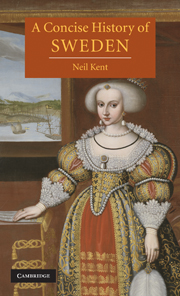Book contents
- Frontmatter
- Contents
- List of illustrations
- Maps
- Preface
- 1 From prehistory to Viking hegemony
- 2 The formation and growth of the Swedish state
- 3 The territorial consolidation of Sweden
- 4 Towards a centralist and military state
- 5 The collapse of absolutism and the Age of Freedom
- 6 Royal absolutism restored
- 7 Constitutional Sweden
- 8 The industrialisation and capitalisation of Sweden
- 9 The world wars and Swedish neutrality
- 10 Triumph of the Swedish welfare state
- Conclusion
- Appendix 1 Chronology
- Appendix 2 Monarchs and regents of Sweden
- Appendix 3 Prime ministers
- Selected further reading
- Index
5 - The collapse of absolutism and the Age of Freedom
Published online by Cambridge University Press: 05 June 2014
- Frontmatter
- Contents
- List of illustrations
- Maps
- Preface
- 1 From prehistory to Viking hegemony
- 2 The formation and growth of the Swedish state
- 3 The territorial consolidation of Sweden
- 4 Towards a centralist and military state
- 5 The collapse of absolutism and the Age of Freedom
- 6 Royal absolutism restored
- 7 Constitutional Sweden
- 8 The industrialisation and capitalisation of Sweden
- 9 The world wars and Swedish neutrality
- 10 Triumph of the Swedish welfare state
- Conclusion
- Appendix 1 Chronology
- Appendix 2 Monarchs and regents of Sweden
- Appendix 3 Prime ministers
- Selected further reading
- Index
Summary
THE END OF THE GREAT NORTHERN WAR
Karl XII’s sudden death in battle against Norway was disastrous for Sweden. In its immediate aftermath, the country’s military campaign collapsed and Sweden’s vulnerability, militarily, economically and politically, was laid bare. Bohuslän, in the west, was set upon by the Norwegians under Peder Tordenskjold, while funds earmarked for the campaign disappeared in the confusion. Russia’s sudden attack upon Sweden’s largely undefended east coast in 1719 added further devastation. Södertälje was burnt to the ground and other cities, as far north as Umeå, suffered badly. In Finland, many men were carted off to Russia as prisoners of war, conscripted into Russian military service or set to work as serfs. Many of those who escaped capture fled to Sweden, where they settled new homesteads, never to return to their native land. Stockholm, it is true, under Rutger Fuchs (1682–1753) successfully resisted the Russian invasion, but the country was in no position to resist for long. In consequence, Sweden was obliged to accept very severe impositions, not least the loss of much of the German territory it had acquired in the course of the Thirty Years War, in particular Bremen and Verden to Hanover, though some financial compensation for them was provided. Wollin and Usedom, among other pieces of land in Hinter Pomerania, were ceded to Prussia. Only that part of the province to the west of the River Peene remained in Swedish hands.
- Type
- Chapter
- Information
- A Concise History of Sweden , pp. 101 - 128Publisher: Cambridge University PressPrint publication year: 2008



